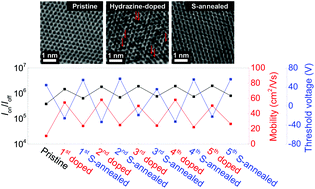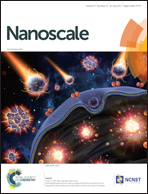Sulfur vacancy-induced reversible doping of transition metal disulfides via hydrazine treatment†
Abstract
Chemical doping of transition metal dichalcogenides (TMDCs) has drawn significant interest because of its applicability to the modification of electrical and optical properties of TMDCs. This is of fundamental and technological importance for high-efficiency electronic and optoelectronic devices. Here, we present a simple and facile route to reversible and controllable modulation of the electrical and optical properties of WS2 and MoS2via hydrazine doping and sulfur annealing. Hydrazine treatment of WS2 improves the field-effect mobilities, on/off current ratios, and photoresponsivities of the devices. This is due to the surface charge transfer doping of WS2 and the sulfur vacancies formed by its reduction, which result in an n-type doping effect. The changes in the electrical and optical properties are fully recovered when the WS2 is annealed in an atmosphere of sulfur. This method for reversible modulation can be applied to other transition metal disulfides including MoS2, which may enable the fabrication of two-dimensional electronic and optoelectronic devices with tunable properties and improved performance.



 Please wait while we load your content...
Please wait while we load your content...